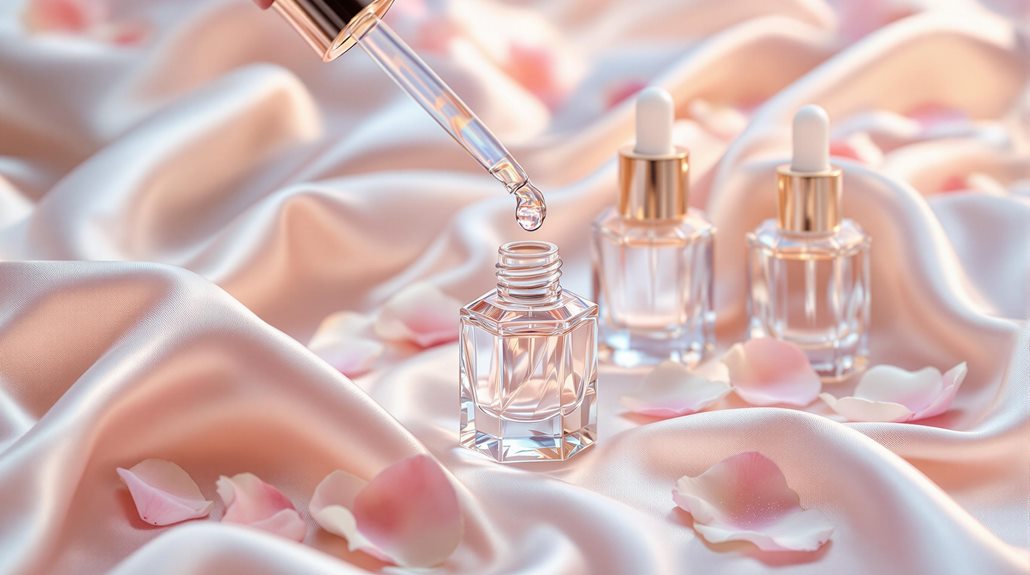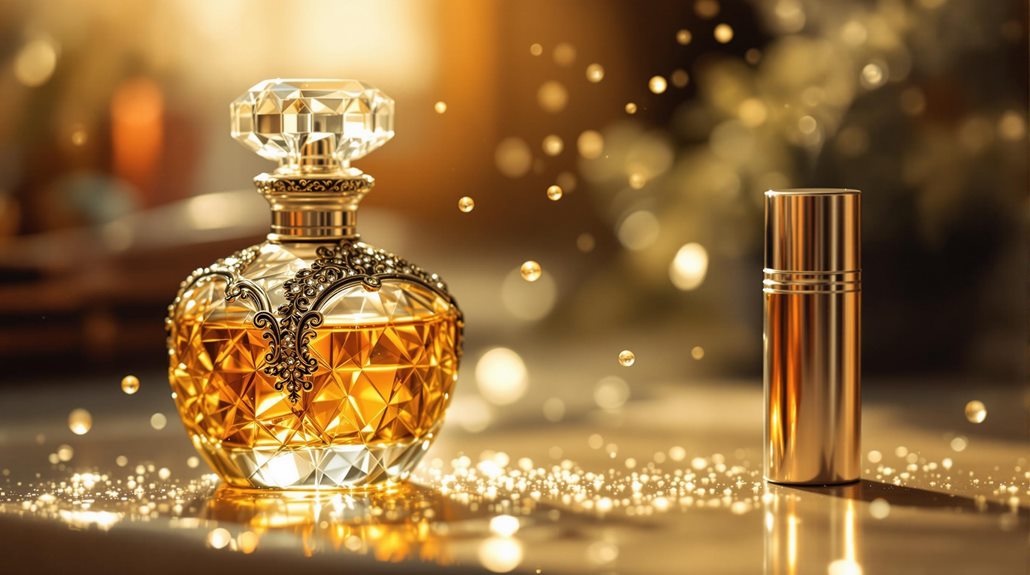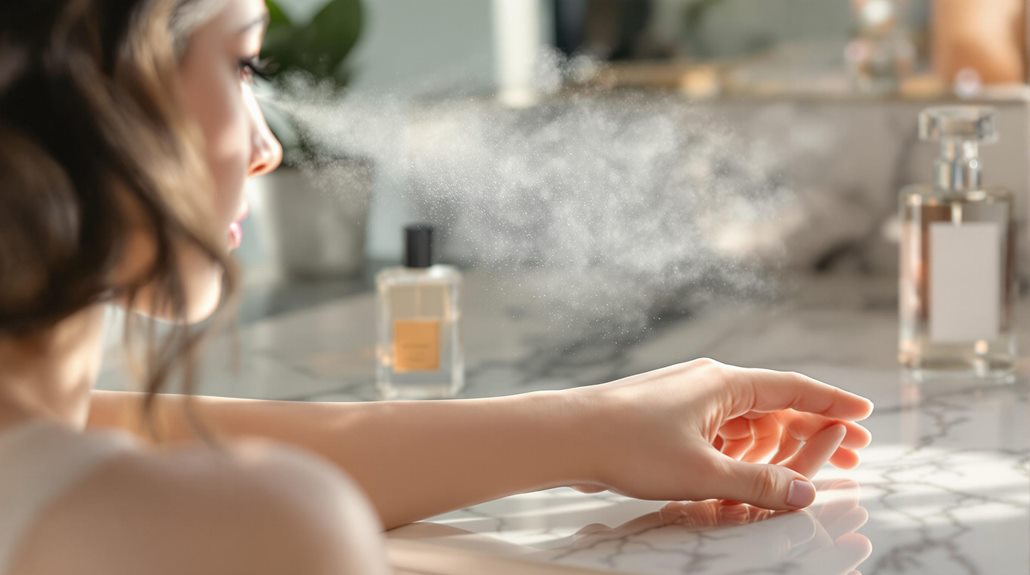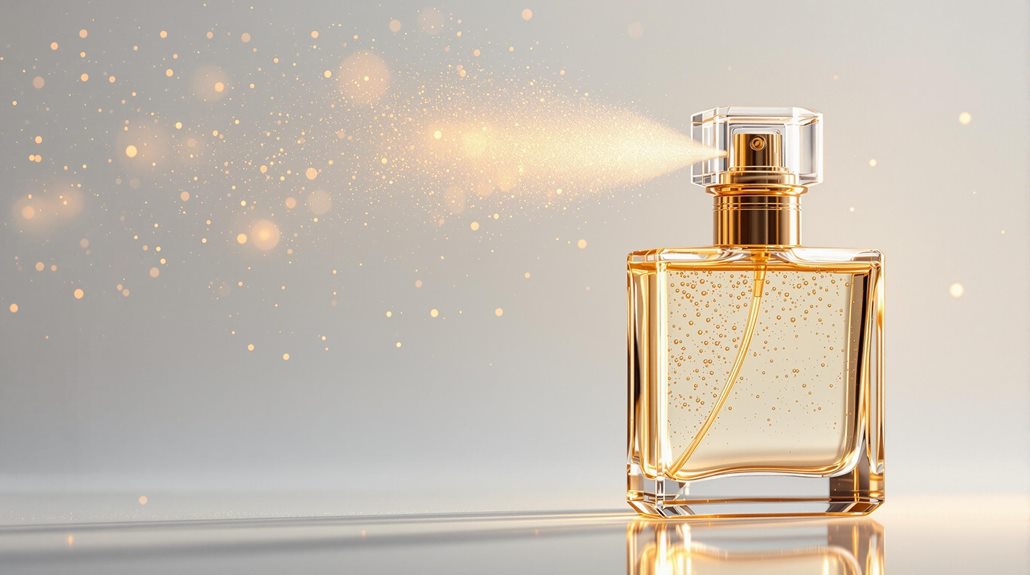Transferring Perfume From One Bottle to Another: a Step-By-Step Guide
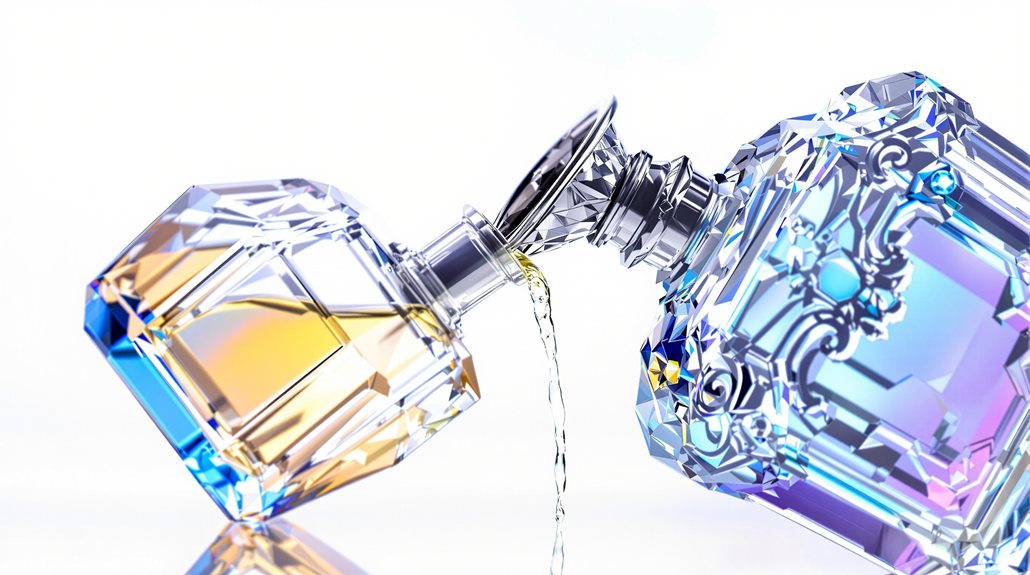
Transferring perfume between bottles requires proper preparation and precise technique to maintain fragrance quality. You'll need clean, dry equipment including funnels, pipettes, and protective gloves to guarantee a successful transfer. Start by thoroughly cleaning and drying your new bottle, then carefully remove the caps from both containers. Position them on a stable, padded surface in a well-ventilated area. Using a funnel, slowly pour the perfume into its new container, taking care to prevent spills and minimize air exposure. While this basic overview covers the essentials, becoming an expert in the finer points will help you achieve professional-level results.
Why Transfer Your Perfume
Whether you're a frequent traveler or an eco-conscious consumer, transferring perfume between bottles offers several alluring benefits. When you refill your perfume bottles instead of purchasing new ones, you'll substantially reduce your expenses while maintaining access to your favorite fragrances. This cost-effective approach allows you to make the most of your perfume investment and minimize waste.
For environmentally conscious individuals, the decision to transfer and refill perfume makes perfect sense. By reusing bottles, you're actively participating in sustainable practices and supporting the circular economy. You'll decrease the number of glass containers that end up in landfills while still enjoying your preferred scents.
The convenience of transferring perfume is particularly appealing for those who travel frequently. With a smaller, refillable bottle, you can easily carry your signature scent wherever you go without lugging around full-sized containers. Using proper tools like a funnel guarantees a clean transfer process, preventing spills and maintaining the perfume's quality. The entire process is straightforward when you have the right equipment and follow proper cleaning and transfer procedures, making it a practical solution for perfume enthusiasts.
Essential Tools and Materials
To make your perfume transfer successful, you'll need the right equipment. Start by gathering clean, dry funnels that fit your new Bottles perfectly. These will help you pour your fragrance smoothly from the original container without any wasteful spills or messy cleanup.
For more precise transfers, especially when working with Refill Perfume Bottles that have narrow openings, you'll want to use either pipettes or small syringes. These tools give you maximum control over the amount of perfume you're transferring and help prevent overflow. Place protective gloves on your hands before you begin - they'll keep the fragrance off your skin and essential to prevent you from contaminating the perfume during transfer.
Consider investing in refillable atomizers, particularly if you frequently transfer perfumes for travel. These specialized containers are designed specifically for easy refilling and portable use. Having the right tools not only makes the process more efficient but also helps preserve the quality of your fragrance. Remember that clean equipment is indispensable - any residue or moisture can affect your perfume's composition, so important to ensure all your tools are completely dry before use.
Safety Precautions Before Starting
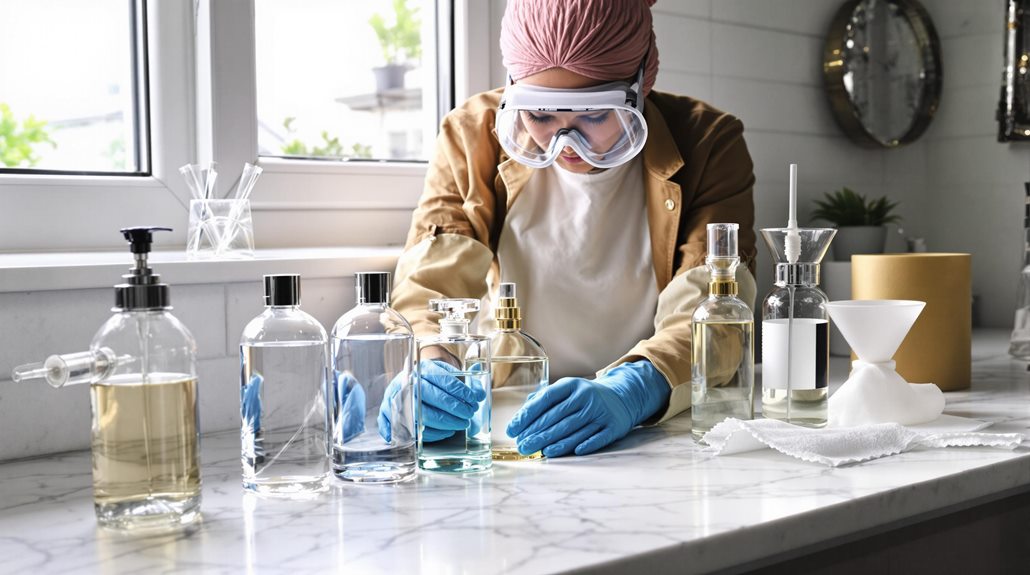
Safety should always be your top priority when transferring perfumes between bottles. Before you begin the process, it's paramount to take proper precautions to protect yourself and preserve the quality of your fragrance. Start by putting on protective gloves to shield your skin from direct contact with the perfume and guarantee you'll have a firm grip on the bottles. Set up your workspace in a well-ventilated area to minimize your exposure to strong scents and volatile compounds.
Place a padded surface, such as a folded towel or soft mat, on your work area to prevent bottle breakage. Before starting the transfer, carefully inspect each bottle for cracks, leaks, or signs of damage. Remember that extended air exposure can alter the perfume's composition, so you'll want to work efficiently.
- You'll protect your cherished fragrance from contamination
- You'll preserve the scent's unique character and complexity
- You'll safeguard yourself from potential skin irritation
- You'll prevent costly accidents and spills that could waste your prized perfume
Preparing Your Bottles
Moving forward with your perfume transfer, proper bottle preparation guarantees a successful and clean transfer process. Begin by thoroughly washing your empty perfume bottle with warm water and mild soap to remove any residual fragrance or debris. Rinse it multiple times until it's completely clean and free of any soap residue.
Next, allow both the empty perfume bottle and your new bottle to air dry completely. You'll want to make certain there's absolutely no moisture inside, as water can alter the perfume's chemical composition. While waiting, inspect both bottles carefully for any cracks, chips, or damage that could compromise the transfer.
Prepare your small funnel by washing it with rubbing alcohol and letting it dry thoroughly. If you're using a metal funnel, make sure it's totally dry to prevent oxidation. Position your clean bottles on a stable, flat surface covered with paper towels to catch any potential spills. Remove the spray nozzle or cap from both bottles, guaranteeing the openings are unobstructed. Once everything is completely dry and properly positioned, you're ready to proceed with the transfer process.
Removing Original Bottle Caps
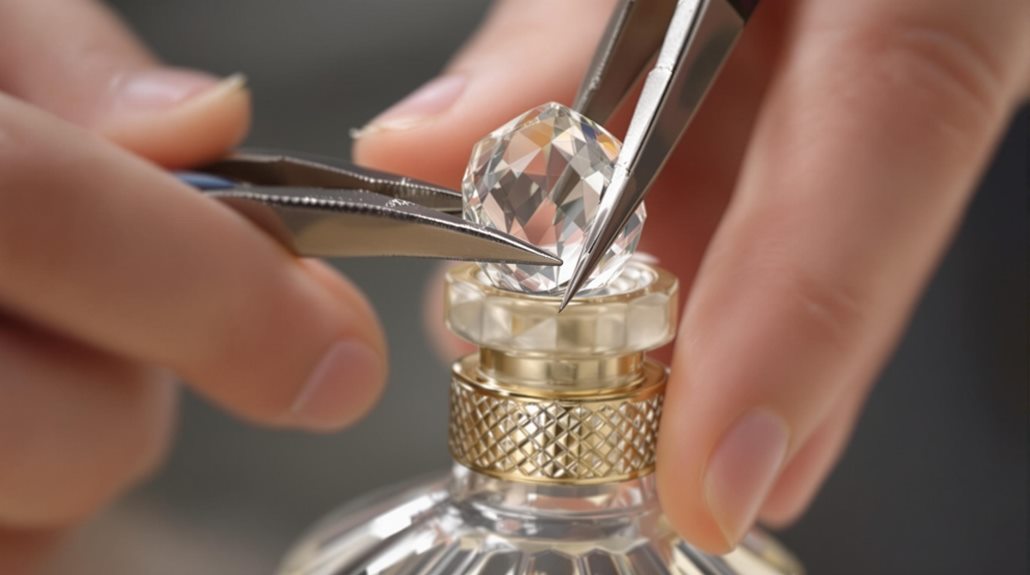
Most perfume bottles feature different types of caps that you'll need to carefully remove before transferring the fragrance. The original bottle may have a spray mechanism that's tightly secured or a simple screw-on cap. You'll want to examine the top of the bottle carefully to determine the best removal method without damaging the container or spilling the perfume.
- Don't force a stuck atomizer onto the bottle - this could crack the glass and ruin your precious fragrance
- Handle vintage perfume caps with extra care, as older mechanisms can be more delicate and irreplaceable
- Watch out for sharp edges when removing crimped-on caps, as they can cause painful cuts or scrapes
- Take your time with decorative caps - rushing could damage both the cap and bottle neck
For spray bottles, grip the plastic collar at the neck's base and gently twist counterclockwise while pulling upward. If you encounter resistance, try wrapping a rubber band around the collar for better grip. Once removed, you can begin pouring the perfume bottle through the funnel into your new container. Some caps may require special tools or techniques, so research your specific bottle type if you're unsure.
Proper Cleaning Methods
Before transferring perfume to a new container, proper cleaning of both bottles is necessary to prevent contamination and maintain the fragrance's purity. Start by washing the empty bottle with warm, soapy water, taking care to remove any residue from previous contents. Rinse thoroughly multiple times with distilled water to guarantee no soap remains.
For stubborn residues, you can use a mixture of equal parts white vinegar and water, followed by another thorough rinse. Make sure to clean the bottle's neck and threading carefully, as these areas often harbor hidden debris that could affect the Tight Seal of your perfume transfer.
After cleaning, let the bottle dry completely in a dust-free environment. You can expedite this process by using compressed air or letting it air dry upside down on a clean paper towel. Don't use cloth towels, as they may leave behind lint. Check that the interior is completely moisture-free by holding the bottle up to a light source - any remaining water droplets could dilute your perfume or cause the scent to deteriorate over time.
The Transfer Process
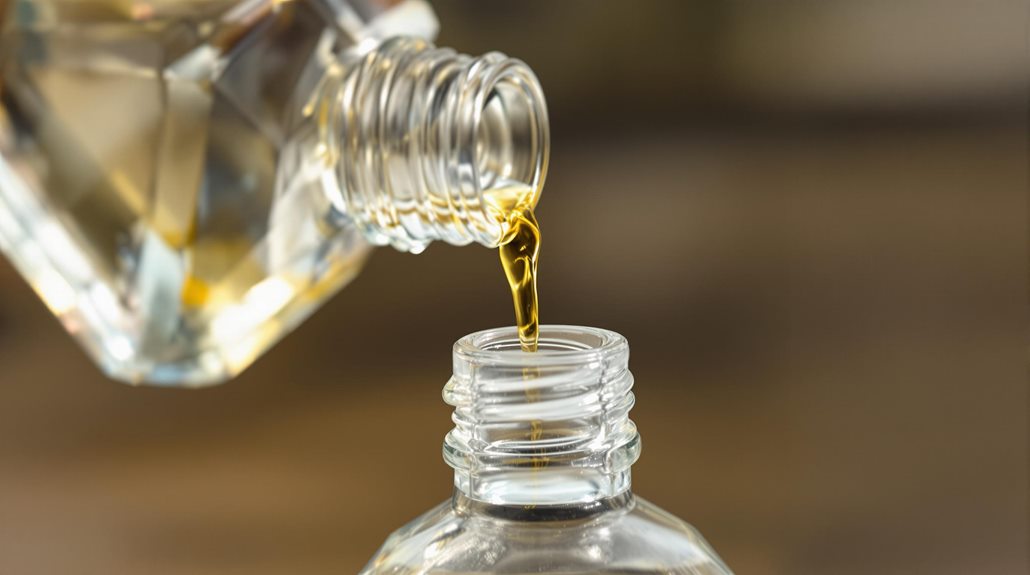
When transferring perfume, you'll need a small funnel and steady hands to prevent spills and evaporation. Before you transfer perfume from one bottle to another, guarantee you have the Right Tools ready. Most perfume bottles are designed with crimped sprayers that you'll need to remove carefully. Using pliers, gently push and twist the sprayer mechanism until it comes loose.
- You'll feel a sense of satisfaction as you successfully remove the sprayer without damaging the bottle or spilling any precious fragrance
- The anticipation builds as you position your funnel securely in the new bottle's opening
- There's a moment of careful concentration as you begin pouring your cherished perfume
- You'll experience relief when the transfer is complete and your fragrance is safely in its new home
To Avert Leaks during the transfer, hold both bottles at a slight angle and pour slowly. If you're working with a large amount of perfume, consider transferring it in small batches to minimize the risk of accidents. Once complete, immediately secure the new bottle's sprayer to prevent evaporation and contamination.
Securing the New Bottle
After completing the transfer, proper bottle sealing becomes your next priority. When transferring perfume from one bottle to the new one, you'll need to guarantee an airtight seal to preserve the fragrance's integrity and prevent evaporation. For glass bottles, check that the spray mechanism or cap fits snugly without any gaps. If you're using a screw-top closure, tighten it firmly but not excessively to avoid damaging the threads.
If you've opted for metal or plastic containers when transferring the perfume, verify that all components are compatible with your fragrance, as some perfumes can react with certain materials. Test the seal by turning the bottle upside down briefly over a paper towel to check for leaks. You can reinforce the seal using plumber's tape around the threads or a small amount of clear nail polish on screw-top bottles.
Store your newly filled bottle upright in a cool, dark place for 24 hours to secure the seal holds. During this time, avoid shaking or moving the container unnecessarily. If you notice any leakage, you'll need to adjust the seal or consider using a different container.
Testing Your Newly Filled Bottle
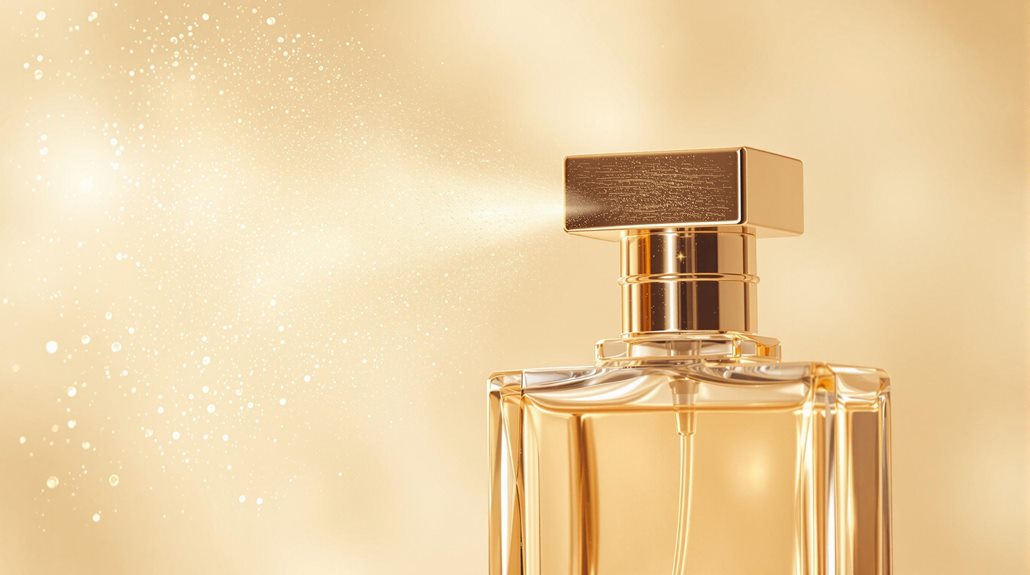
Three key tests will confirm your perfume transfer's success. First, spray the bottle several times to check the atomizer's functionality and guarantee there aren't any leaks. Next, compare the scent with the original fragrance to verify it hasn't been altered during transfer. Finally, examine the spray pattern to ascertain it's dispensing an even, fine mist.
Store your newly filled bottle in a dark place away from direct sunlight and heat to maintain its integrity while you monitor its performance. Over the next few days, you'll want to test the fragrance's longevity and watch for any premature evaporation. Keep the bottle in a dry place away from temperature fluctuations as you assess its performance.
A clean, consistent spray that mirrors the original bottle's performance
The same beloved fragrance notes you've come to expect, without any alterations
Proper longevity that matches your original perfume's staying power
A securely sealed bottle that prevents leakage and preserves the scent's intensity
If any issues arise during testing, you may need to adjust the atomizer or consider redoing the transfer process.
Storage and Maintenance Tips
Proper storage and regular maintenance of your refilled perfume bottles guarantee their longevity and preserve their original fragrance. The best way to store your perfume is in a cool, dark place away from direct sunlight and heat sources. A drawer, cabinet, or dedicated perfume box can serve as the perfect new home for your transferred fragrances.
Make sure you've left some space at the top of each bottle to allow for natural expansion and contraction of the perfume. You'll want to regularly inspect your bottles for any signs of leakage or changes in the fragrance's character. If you notice any alterations in the scent or appearance, it's time to evaluate disposing of the perfume properly.
For maximum freshness and convenience, contemplate using travel perfume bottles for your transfers. These smaller containers help maintain the fragrance's integrity and reduce waste from larger bottles that might go unused. Remember to clean out any partially used perfumes that have been stored for too long, as their scent quality may have already deteriorated beyond acceptable levels.
Conclusion
Now that you've successfully transferred your perfume, you'll want to maintain its quality. Store your newly filled bottle in a cool, dark place away from direct sunlight and heat. Don't forget to check the seal regularly to prevent evaporation. If you've followed all steps carefully, you'll enjoy your favorite fragrance from its new container for months to come.

